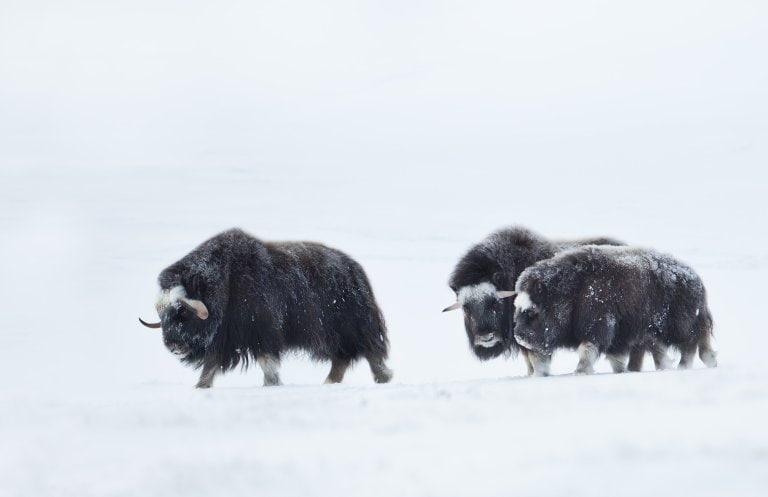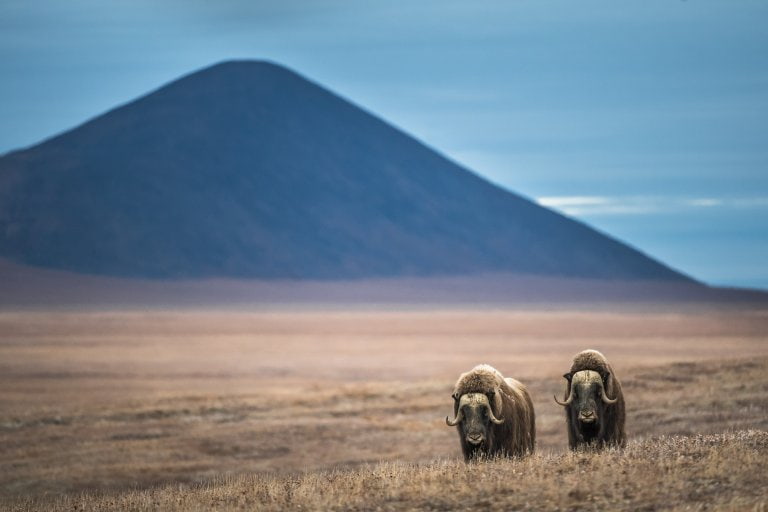Muskox Profile
The Arctic is an unforgiving environment, and those who thrive there are not to be trifled with.
The muskox also spelt ‘musk ox’, is a shaggy-haired, hoofed mammal that belongs to the same family as cattle, bison and buffalo. They are native to the Arctic and are named after their strong odor emitted by males to attract females during the seasonal rut.
They are a perfect example of the Homer Simpson Defense, sitting it out until any competition can no longer hack it.

Muskox Facts Overview
| Habitat: | Arctic tundra |
| Location: | Circumpolar |
| Lifespan: | 14-20 years |
| Size: | Up to around 2.5m meters long |
| Weight: | Up to 400kg |
| Color: | Mostly black, brown and grey |
| Diet: | Generally any vegetation available |
| Predators: | Humans, bears, wolves |
| Top Speed: | 60 kph (37 mph) |
| No. of Species: |
1 |
| Conservation Status: |
Least Concern, IUCN |
There are very few animals as tough as a bovid, and there are very few bovids as hardcore as a muskox. They’re huge, powerful, and quite content in the frozen tundra of the Arctic.
They’re known for their heavy scent and incredible fur.
Both males and females stand between 1-1.5m (3ft 7 – 4ft 11) in height and have long, curved horns that they use for protection.
Muskox will spend their time in herds of 12-24 in river valleys and other wet areas, avoiding deep snow where possible and dieting on grasses, woody plans and lichen.
They are not aggressive, but have been known to occassionally attack humans that venture too near.
Interesting Muskox Facts
1. They’re musk-ish
Musk is more than just a scent, it’s actually a glandular secretion made by a number of different animals. It can be overwhelming at first, but when refined, it’s often used as a base for perfume for its powerful aroma.
Ironically, the Muskox doesn’t have these glands. During the breeding season, to make up for it, they just piss all over themselves. Added to this is a preorbital scent gland that certainly complements the undertones of urine with a layer of complexity over the top of it.
Native people have commented that the caribou don’t like to be around muskox because they’re so stinky, but this may have more migratory reasons. 1

2. They’re non-migratory
Winters in their habitat are long, dark and windy, and there’s not a lot to eat. Caribou are the only large animal in the Arctic with populations greater than the muskox, yet these will move from one location to another to avoid the worst of the weather and find food.
The muskox isn’t built for that, and prefers to stay put, facing some of the harshest weather on the planet with ease, backed up by a range of cold-weather adaptations to keep it comfortable. 2
3. They achieve this by being fat and hairy
One great defence against the cold is fat. And the muskox is seriously rotund. They have short legs, cylindrical bodies and immense amounts of dense fur that all combine to keep them warm.
The outer layer of fur gives them a shaggy mane in some cases, and can often grow all the way to the ground in older animals. This skirt protects their tiny knees from drafts and mozzies, but the majority of the insulation comes from their undercoat.
This is grown seasonally and is incredibly fine and densely packed, acting as thermal underwear and keeping the muskox warm enough to just stand around while the Caribou moves onto warmer climes.

4. They are heterothermic
Their ability to live in freezing temperates is not just down to being large and hairy.
They are also heterothermic, which means they can shut down thermal regulation to body parts like lower limbs to reduce body heat loss from more important areas.
They are also able to store more oxygen in their blood in cold climates, due to unique hemoglobin that is three times less temperature sensitive than human hemoglobin.
5. They’re butt heads
When male mammals get aroused they tend to do silly things. And during the breeding season, male muskox run at each other with their heads down.
These heads pack a serious punch, and males will often collide at a combined speed of around 80kmh. This is, of course, if the ritualistic head swinging, posturing, and peeing on their own feet isn’t enough to show their competitor they’re not to be messed with.
This incredible collision is how the males show strength and compete for access to the onlooking harem. The power of these enormous beasts is concentrated on hardened bosses on their horns, and absorbed into their thick neck and back muscles.
Eventually, after as many as twelve or more clashes, one of the males will get tired and concede, and incredibly, neither male is usually badly damaged by any of this. Still, mating season is hard work for male muskox, and they’ll typically live 5-10 years less than the females. 3
6. They can easily overheat
With all that exceptionally insulating fur and dense muscle, it’s easy for muskox to overheat if they engage in too much strenuous activity.
On the occasions when they’re chased by predators, this alone can be fatal. As a result, they try to move slowly and stay close to home. Though, they are known to chase each other around playfully sometimes.
7. They can form a defensive circle
When predators have their eyes on a juicy young muskox, they have a lot of horns to contend with.
Both males and females have them, and they’re put to good use when the giant bovids form a defensive circle around the youngsters, horns facing outwards.
Wolves and bears need to find a way past these sharp horns and immense headbutts to get to their meal, and this isn’t an easy task. Wolves do get killed when taking on a muskox, and will try hard to break apart the circle to get a chase going instead. 4
8. Their fur fetches a high price
But it’s not just wolves and bears to deal with. Human hunters are plenty capable of killing muskox.
Subsistence hunters have traditionally taken them for their meat and wool, and this extends to the international community.
Muskox yarn fetches up to $3 a gram, and the wool itself if finer than cashmere, and eight times warmer than sheep wool.
Which is one of many comparisons that are becoming apparent between the muskox and their Ovine cousins…

9. They’re more closely related to sheep and goats
Despite looking like a cow, the muskox has recently been determined to be a member of the Caprinae subfamily, a clade that includes sheep and goats, which may explain a lot of the head-butting behaviour, stubbornness, and awesome wool.
10. They’ve made a comeback
Historically, muskox declined because of overhunting and possibly climate change, but their population size has recovered due to improved hunting regulations and reintroduction to various countries.
There’s thought to be between 80,000 and 125,000 muskox living in the wild today.
Muskox Fact-File Summary
Scientific Classification
| Kingdom: | Animalia |
| Phylum: | Chordata |
| Class: | Mammalia |
| Order: | Artyodactyla |
| Family: | Bovinae |
| Subfamily: | Caprinae |
| Tribe: | Ovibovini |
| Genus: | Ovibos |
| Species: | Ovibos Moschatus |
Fact Sources & References
- David R. Gray, Peter F. Flood, and Janice E. Rowell (1989), “The structure and function of muskox preorbital glands“, Canadian Science Publishing.
- Sarah Marie Elder, “Ovibos moschatus muskox“, Animal Diversity Web.
- “Viking Wilderness – Muskox High Speed Collision“, Animal Planet
- “Musk Ox“, National Geographic.
